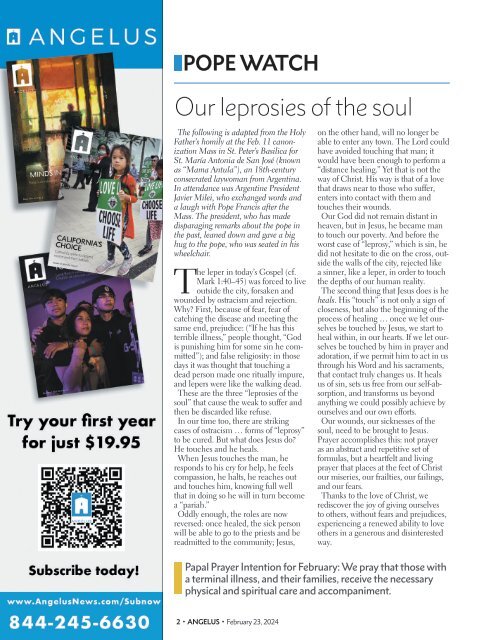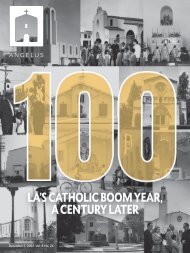Angelus News | February 23, 2024 | Vol. 9 No. 4
On the cover: A painting depicting Jesus in the Garden of Gethsemane by 19th-century artist Carl Heinrich Bloch. For Christians, Lent can be compared to the time Jesus spent praying in the desert. But we may also find ourselves this time of year in the agony of the garden, going through our own Gethsemane of personal suffering. On Page 10, Msgr. Richard Antall reflects on two traditional prayers to the same angel that comforted Christ on the Mount of Olives.
On the cover: A painting depicting Jesus in the Garden of Gethsemane by 19th-century artist Carl Heinrich Bloch. For Christians, Lent can be compared to the time Jesus spent praying in the desert. But we may also find ourselves this time of year in the agony of the garden, going through our own Gethsemane of personal suffering. On Page 10, Msgr. Richard Antall reflects on two traditional prayers to the same angel that comforted Christ on the Mount of Olives.
Create successful ePaper yourself
Turn your PDF publications into a flip-book with our unique Google optimized e-Paper software.
POPE WATCH<br />
Our leprosies of the soul<br />
The following is adapted from the Holy<br />
Father’s homily at the Feb. 11 canonization<br />
Mass in St. Peter’s Basilica for<br />
St. María Antonia de San José (known<br />
as “Mama Antula”), an 18th-century<br />
consecrated laywoman from Argentina.<br />
In attendance was Argentine President<br />
Javier Milei, who exchanged words and<br />
a laugh with Pope Francis after the<br />
Mass. The president, who has made<br />
disparaging remarks about the pope in<br />
the past, leaned down and gave a big<br />
hug to the pope, who was seated in his<br />
wheelchair.<br />
The leper in today’s Gospel (cf.<br />
Mark 1:40–45) was forced to live<br />
outside the city, forsaken and<br />
wounded by ostracism and rejection.<br />
Why? First, because of fear, fear of<br />
catching the disease and meeting the<br />
same end, prejudice: (“If he has this<br />
terrible illness,” people thought, “God<br />
is punishing him for some sin he committed”);<br />
and false religiosity: in those<br />
days it was thought that touching a<br />
dead person made one ritually impure,<br />
and lepers were like the walking dead.<br />
These are the three “leprosies of the<br />
soul” that cause the weak to suffer and<br />
then be discarded like refuse.<br />
In our time too, there are striking<br />
cases of ostracism … forms of “leprosy”<br />
to be cured. But what does Jesus do?<br />
He touches and he heals.<br />
When Jesus touches the man, he<br />
responds to his cry for help, he feels<br />
compassion, he halts, he reaches out<br />
and touches him, knowing full well<br />
that in doing so he will in turn become<br />
a “pariah.”<br />
Oddly enough, the roles are now<br />
reversed: once healed, the sick person<br />
will be able to go to the priests and be<br />
readmitted to the community; Jesus,<br />
on the other hand, will no longer be<br />
able to enter any town. The Lord could<br />
have avoided touching that man; it<br />
would have been enough to perform a<br />
“distance healing.” Yet that is not the<br />
way of Christ. His way is that of a love<br />
that draws near to those who suffer,<br />
enters into contact with them and<br />
touches their wounds.<br />
Our God did not remain distant in<br />
heaven, but in Jesus, he became man<br />
to touch our poverty. And before the<br />
worst case of “leprosy,” which is sin, he<br />
did not hesitate to die on the cross, outside<br />
the walls of the city, rejected like<br />
a sinner, like a leper, in order to touch<br />
the depths of our human reality.<br />
The second thing that Jesus does is he<br />
heals. His “touch” is not only a sign of<br />
closeness, but also the beginning of the<br />
process of healing … once we let ourselves<br />
be touched by Jesus, we start to<br />
heal within, in our hearts. If we let ourselves<br />
be touched by him in prayer and<br />
adoration, if we permit him to act in us<br />
through his Word and his sacraments,<br />
that contact truly changes us. It heals<br />
us of sin, sets us free from our self-absorption,<br />
and transforms us beyond<br />
anything we could possibly achieve by<br />
ourselves and our own efforts.<br />
Our wounds, our sicknesses of the<br />
soul, need to be brought to Jesus.<br />
Prayer accomplishes this: not prayer<br />
as an abstract and repetitive set of<br />
formulas, but a heartfelt and living<br />
prayer that places at the feet of Christ<br />
our miseries, our frailties, our failings,<br />
and our fears.<br />
Thanks to the love of Christ, we<br />
rediscover the joy of giving ourselves<br />
to others, without fears and prejudices,<br />
experiencing a renewed ability to love<br />
others in a generous and disinterested<br />
way.<br />
Papal Prayer Intention for <strong>February</strong>: We pray that those with<br />
a terminal illness, and their families, receive the necessary<br />
physical and spiritual care and accompaniment.<br />
2 • ANGELUS • <strong>February</strong> <strong>23</strong>, <strong>2024</strong>

















